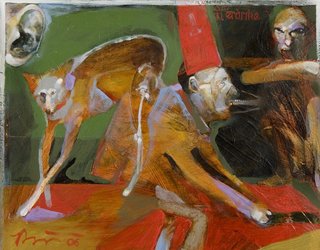 |
Rick Bartow's enigmatic "Fools Share of the Burden" mingles figures suggestive of earlier European artists' as well as Indian shape-shifter forms. b. sakata garo
|
| |
|
The pain of the past shadows the present in Oregon artist Rick Bartow's graphically
bold and emotionally complex works at b. sakata garo. The horrors of the Vietnam War,
struggles with alcoholism, and the deaths of beloved friends and family members are among
the traumatic events that have shaped his work. Yet his pastels, paintings and sculpture
transcend the darkness that threatens to engulf them.
Rebecca J. Dobkins, curator of
American Indian art at Willamette University's Hallie Ford Museum, from which I have drawn much
of the information in this article, provides an insightful, in-depth exploration of Bartow's work in
her fine book, "Rick Bartow: My Eye," which accompanied an exhibition at the museum in 2002.
As Dobkins points out, transformation is at the heart of Bartow's vision, which draws both on his Northern
California Indian heritage and his knowledge of art history and world art. While he is one of the most prominent
Indian artists in the country, it would be a mistake to look at his work only through that lens.
Sources as diverse as Maori wood carving, African nail fetishes and Japanese art inform his pieces,
as does the work of European and American artists such as Hieronymus Bosch, Francis Bacon and Fritz Scholder.
One also can see affinities with the work of Northern California artists. Some of his images remind you
of Manuel Neri in their sensuality and deep eroticism while others call up the mordant, brooding spirit of Nathan Oliveira.
But while you see flashes of things that seem familiar, Bartow's works achieve a synthesis that is purely his own.
Bartow's large pastels offer compelling images in which animals and humans become each other through spiritual
transformation. Using traditional Indian tutelary spirits such as Coyote, Bear, Hawk and Crow, he captures figures in
transition, poised between human and animal, that serve as a metaphor for the transformative function of art. In these
works the artist's hand often appears reaching up from outside the picture plane or in ghostly hand prints that give the
feeling the work is still in process.
Bartow often uses large areas of white to guide the eye up to the climax of
his mark-making action, as in "Water and Segyp," an image of a bird whose beak is also a human mouth. Conversely,
in "Quiet Hawk in the Morning" he uses saturated blacks and an intense, nearly physical purple pigment to deliver a
strong visual punch.
"Crow Love/Death" explores the age-old themes of Eros and Thanatos with images of a ghostly
skull, a golden beak, and deep red nipples emerging from a field of impassioned blacks and blues.
In a series of smaller acrylic paintings, Bartow gives raw, expressionistic takes on the human figure in
"Fiercely Female," "MacBeth" and "One More Little Nightmare."
Looser and more searching than some of the larger pastels, "Fools Share of the Burden" and "Puppets and Fools,"
which include words written in German script, address the Holocaust and other terrifying wages of war. Mingling figures
reminiscent of Bosch and Brueghel, James Ensor and the German expressionists, and American Indian shape shifters, they are fascinating yet enigmatic narratives done with subtle color and a light hand.
Equally arresting are a trio of Bartow's wood and found object sculptures. Inspired by Northwest Coast Indian art, he first studied traditional images and techniques but eventually began incorporating his own experiences into works that dealt with transformation in new ways. The sculptures at b. sakata garo take the form of dogs or coyotes that are in the process of becoming more than they are.
Adopting the ritualistic aspects of Congolese nail fetishes, in which prayers or warnings are uttered as the nails are pounded, and adding tar, hair, lead and twine, he gives us raw yet richly symbolic creatures with bodies that turn into heads and heads that sprout small figures. "Coyote Dreaming" sports a Janus-like double-faced head and is topped by a hank of hair.
"Dog Observed" is crudely gouged out of wood and features a body that is also a head with its tongue sticking out, a traditional Maori gesture of challenge.
"Mama Dog," with nails driven into its back suggesting hair rising up in fear or anger, is the most elaborate of
the three. Both humorous and horrific, it has a plexiglass panel on one side that reveals a spindle of twine and a
triangular piece of wood that form an abstract bird, a spirit figure that the mama dog carries inside. It's a powerful
work that contrasts the dual nature of animal mothers who are fearsomely protective of their young and threatening to those
that would harm them.
Rick Bartow
WHERE: b. sakata garo, 923 20th St.
WHEN: Noon to 6 p.m. Tuesdays-Saturdays, through June 30
INFORMATION: (916) 447-4276
